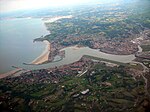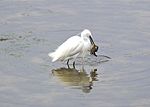Hendaye station

Hendaye station (French: Gare d'Hendaye) is a railway station in Hendaye, France, on the Bordeaux-Irun and Madrid-Hendaye lines. The station is served by TGV high speed trains, Intercités de nuit night trains, Intercités long distance and TER local services operated by the SNCF, Trenhotel and Arco services operated by RENFE, and EuskoTren services. The Euskotren 1,000 mm (3 ft 3+3⁄8 in) metre gauge services operate from a station on the forecourt of the SNCF station, for which separate ticketing is required. The station is a border railway station where all trains have to stop, as those coming from/going into Spain have to change gauge from 1,435 mm (4 ft 8+1⁄2 in) standard gauge to 1,668 mm (5 ft 5+21⁄32 in) Iberian gauge. The electric supply also changes here from 1500 V DC (overhead France) to 3000 V DC (overhead Spain). Between the stations of Hendaye and Irun, both track gauges run together.
Excerpt from the Wikipedia article Hendaye station (License: CC BY-SA 3.0, Authors, Images).Hendaye station
Gare Hendaye, Bayonne
Geographical coordinates (GPS) Address External links Nearby Places Show on map
Geographical coordinates (GPS)
| Latitude | Longitude |
|---|---|
| N 43.3531 ° | E -1.7819 ° |
Address
Hendaye
Gare Hendaye
64700 Bayonne, La Gare
Nouvelle-Aquitaine, France
Open on Google Maps










